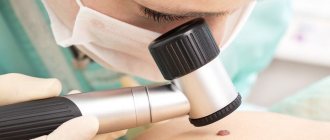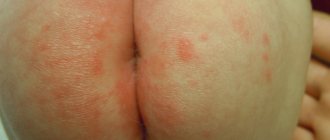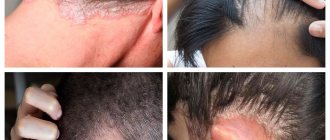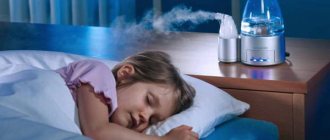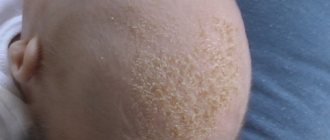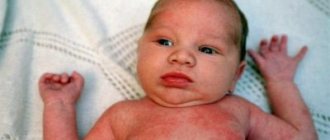How are pustular skin infections transmitted?
Pyoderma or pustular skin diseases are especially common among children. They are often encountered in the practice of a dermatologist, accounting for 30–40% of all calls.
The frequency of pyoderma in childhood is directly related to the lack of personal hygiene of the child himself and the people around him and directly caring for him.
Pyodermas are bacterial skin infections caused by various pathogenic bacteria. The main causative agents of dangerous skin pustular infections are gram-positive cocci: staphylococci and streptococci. Also, sometimes the development of pustular skin diseases can be caused by pathogens such as Proteus vulgaris, Pseudomonas aeruginosa and Escherichia coli, etc.
How are these skin infections transmitted? Infection occurs through close skin-to-skin contact, so children who attend preschool institutions are at risk.
There are a number of factors that increase the risk of contracting pyoderma:
- hypothermia and overheating (sweating);
- microtraumas - abrasions, cuts, bites, scratches, abrasions;
- long-term and irrational use of antibiotics;
- the presence of chronic non-infectious dermatoses (atopic and seborrheic dermatitis, eczema, psoriasis, etc.);
- metabolic disorders, especially carbohydrate metabolism;
- malnutrition, hypovitaminosis, anemia.
Symptoms of pyoderma
The external signs of pyoderma are similar to the symptoms of many dermatological diseases. It is very difficult to make a diagnosis on your own, and it is almost impossible to determine the pathogen by the appearance of the rash. Therefore, laboratory tests are most often necessary to determine the causative agent of the disease.
There are several points that will help to suspect pyoderma in a child:
- pustular elements are visualized on the skin;
- the rash tends to spread throughout the body;
- rashes are moist, weeping, with the formation of crusts;
- The most common localization of pyoderma in children is the scalp and facial skin.
Staphyloderma (this is what pyoderma caused by staphylococci is called) is characterized by a deep distribution, and the favorite localization is the scalp.
Streptoderma (a lesion caused by streptococci) is characterized by the formation of small bubbles with cloudy contents, which are surrounded by an inflammatory border. The blisters may burst when touched, and in their place gray crusts form, which fall off completely painlessly and leave no traces.
Treatment of pustular skin infections:
When treating pyoderma, antibiotics are the first-line drugs. They are selected individually based on the results of bacteriological examination of the elements.
Superficial pyoderma is rarely a dangerous skin infection or poses any threat to the baby. Using an antibacterial ointment is usually sufficient.
In severe cases of the disease or a generalized process, oral antibiotic therapy is prescribed. Children are most often prescribed antibiotics from the group of penicillins, cephalosporins or macrolides. Therapy is prescribed for one to two weeks, depending on the extent and severity of the process.
For complicated forms of pyoderma, as well as for infants, treatment is carried out in a hospital setting.
Dermatological diseases in children and adolescents
10.12.2021
Dermatological diseases in children and adolescents (0 to 16 years old) are common. About 30% of childhood diseases are skin pathologies. They vary in age.
Dermatological conditions in the age group 0-2 years:
Most skin conditions during this period of life are benign and transient, but are a significant source of concern for parents. The most common skin manifestations:
- Seborrheic dermatitis of the newborn. Begins in the first 3 months of life. It appears as yellow-brown, greasy, tight-fitting crusts, initially located on the crown (top of the head) and then spreading to the entire scalp. Does not require special treatment. The condition disappears after the first 3 months.
- Diaper dermatitis . It is characterized by inflammation of the skin (bright red color). It is located in the areas covered by the diaper (genitals and buttocks). This is facilitated by moisture and friction. Maintaining the condition requires consultation with a dermatologist and specialized treatment.
- Heat erythema or heat irritation. This is another dermatological condition that is common in young children. This occurs especially in the warm season and occurs in infants who are dressed incorrectly outdoors. It manifests as small pustules (white head lesions) that primarily affect the head, neck and shoulders . To avoid the appearance of erythema heat, the child should be dressed lightly, in cotton clothing and in accordance with the ambient temperature.
- Atopic dermatitis in infants and young children (up to 2 years). It begins around 3-6 months of age. It manifests itself as erythematous lesions (bright red), the surface of which is covered with blisters and crusts, which mainly affect the facial (forehead, cheeks and chin) and sometimes the extremities. Requires a dermatological examination, establishment of standard care and specialized treatment.
Dermatological conditions in the age group 3-5 years:
- Atopic dermatitis in a child over 2 years of age. The lesions are dry, lichenified (the skin is thickened, darkened due to excessive scratching), covered with bloody crusts, and sometimes super-infected lesions. neck , knee, wrist) are mainly affected This is a condition that always requires recommended dermatological treatment depending on age, clinical form, location and severity.
- Impetigo. A superficial bacterial skin infection that is highly contagious. It is caused by Staphylococcus aureus. It begins as blisters that quickly burst, resulting in yellowish crusts. Lesions appear especially around the nose and mouth . Consultation with a dermatologist and local treatment with antiseptics and topical antibiotics are required
- Chicken pox. It begins with a change in general condition and fever. The rash begins as red spots that turn into blisters, first with clear fluid, then cloudy. The vesicles rupture to form crusts. When the crust is forcibly removed , scars are left behind. To prevent superinfection, antipyretics, talc, and a local antibiotic are recommended. If complications occur (superinfection of rashes, prolonged fever, malaise, etc.), it is recommended to consult an infectious disease specialist.
Dermatological conditions in the age group 6-11 years:
- Warts. They are secondary to HPV infection. They are common in children. It mainly affects the hands and soles of the feet . They are transmitted through direct contact or contact with contaminated objects. It is treated with local solutions or destructive methods (cryotherapy or electrotherapy).
- Dermatophytosis. These are skin infections caused by fungi called dermatophytes. Transmission occurs through direct contact with an infected person, through contaminated objects (such as toys), or from pets. It appears as a round, erythematous (red) lesion with blistering and scaling on the surface. As it develops, the center becomes pale, taking on the appearance of a ring. Requires local treatment.
Dermatological diseases in the age group 12-16 years:
- Acne . This is a dermatological disease that begins during puberty under the influence of genetic and hormonal factors. Regardless of the shape, location or severity of acne , it must be treated from the start due to the serious social consequences and risk of scarring.
- Ringworm versicolor . This is a fungal skin infection caused by a fungus that is part of the normal flora of the skin. Excessive sweating , heat and humidity contribute to its development above normal. It is characterized by the appearance of asymptomatic light brown spots, located especially in the torso area.
- Seborrheic dermatitis . This is a common dermatological disease. It mainly affects the scalp, ears , eyebrows and side of the nose . Mild forms cause the well-known dandruff. Treated with shampoos with active ingredients.
Published in Dermatology Premium Clinic
What dangerous fungal skin infections are there?
Mycoses are infectious lesions of the skin caused by pathogenic fungi.
Fungal skin diseases have a broad classification and include trichomycosis, keratomycosis, dermatomycosis, candidiasis, as well as onychomycosis, etc.
One of the most common diseases in preschool institutions is microsporia (belongs to the group of trichomycosis). Among the people, microsporia or, as it is commonly called, contagious dermatophytosis, is known as “ringworm.”
Microsporia is a disease that is the most highly contagious of the entire group of dermatophytosis and is caused by fungi of the genus Microsporum.
You can become infected with ringworm from sick animals (cats, dogs), from humans with trichomycosis, and extremely rarely from soil.
What does microsporia look like?
On smooth skin, ringworm lesions look like swollen, raised round spots that are covered with scales. Gradually, the spots increase in diameter, and a towering corolla forms along their periphery. Very often, vellus hair, and less often eyebrows and eyelashes, are involved in the infectious process.
Bathing a child with ringworm helps spread fungal spores throughout the body, resulting in dozens of new lesions.
Microsporia has very characteristic symptoms. When the hair is infected with a fungus, it loses its vitality, breaks and looks like “stumps” up to 1 cm long. That is why the name “ringworm” was assigned to it.
Another dangerous fungal skin infection from the group of trichomycosis, which is often found in children's groups, is trichophytosis, which is caused by a fungus of the genus Trichophyton violaceum.
A characteristic manifestation of trichophytosis are multiple lesions with a diameter of 1 to 2 cm, located separately from each other and covered with gray-white scales.
To accurately diagnose and differentiate the fungus, the doctor carefully examines the skin and scalp. Be sure to conduct a microscopic examination of the scales for fungi, and also examine the lesions under a fluorescent filter (Wood's lamp): if there is a fungal infection, the elements will have a greenish glow.
The main drugs for the treatment of trichomycosis and other fungal diseases are antimycotic drugs. Both systemic and external antifungal agents are used.
Preventive measures for mycoses include: personal hygiene measures, disinfection measures.
If a patient with a fungal infection of the skin is identified in children's institutions, he is immediately isolated at home and ongoing disinfection is carried out, and children who were in contact with the patient are also examined.
Children's diseases with rash. Vaccinations and immunity assessment
Most childhood infections are accompanied by various rashes. A rash is a general reaction of the body to the toxic effects of a pathogen and its waste products, and the child has an accelerated metabolism, wide blood vessels and good blood circulation.
Children's diseases are best dealt with in childhood. Firstly, this is how the child’s immunity is formed and protection against infections in the future. Secondly, in adulthood, childhood diseases are much more severe, and many of them are especially dangerous during pregnancy.
All infections are highly contagious, progress with fever and have symptoms of a cold. Often, characteristic signs of the rash allow them to be distinguished from each other. Let's look at the main childhood diseases and their distinctive features:
Measles
Recently it was believed that measles had been defeated, but recently outbreaks have been occurring more and more often. This is due to the refusal of mandatory preventive vaccinations. In fact, measles is a serious disease, especially in adolescence and adulthood. It occurs with complications: pneumonia, otitis, and frequent damage to the kidneys, liver and brain. May lead to deafness and blindness. The measles rash is maculopapular (papules - small elevations on the skin), appears on the 3rd day of illness, begins behind the ears and on the face and appears in stages from top to bottom, can have different sizes (polymorphic). Before the appearance of the rash, you can notice white dots on the mucous membrane of the oropharynx, reminiscent of semolina, with a red rim; they are called Filatov-Koplik spots.
Chicken pox
Caused by herpes virus type III. Most children become ill between the ages of 2 and 7 years; at older ages it is more severe. Everyone knows that the rash with chickenpox is in the form of blisters (vesicular). It starts from the scalp, spreading throughout the body. First, spots appear, which successively turn into papules and itchy blisters with transparent contents, leaving behind crusts. All these elements can be simultaneously observed on the child’s body. In adults, the infection can occur as shingles.
Rubella
It is highly contagious, often mild in both children and adults, and therefore may go undetected. It is particularly dangerous during pregnancy, as it can lead to the formation of fetal developmental abnormalities for up to 12 weeks. Typical manifestations: enlargement of the occipital and posterior cervical lymph nodes, a small spotted rash, without pain or itching.
Scarlet fever
Caused by group A beta-hemolytic streptococcus. It manifests itself as a sore throat and a typical pinpoint rash against the background of severe redness of the skin. Most of the rash elements are in the area of the flexor surfaces and they tend to merge. The nasolabial triangle always remains free of rash. Another sign is a bright red tongue.
Erythema infectiosum
Caused by parvovirus B19. In children, it is widespread, mild, with signs of a cold, and possible headache. The hallmark is bright redness of the cheeks, which is why parvovirus infection is better known as “slapped cheek disease.” Dangerous in the first trimester of pregnancy.
Roseola
Caused by herpes virus type VI. Mostly children under 5 years of age are affected. The disease is rarely recognized because in the first 3 days the temperature rises sharply to 39-40 degrees, on the 4th day it drops to normal numbers without signs of a cold, and a rash resembling rubella appears. Few people realize that these are manifestations of the same disease. In adults it causes chronic fatigue syndrome.
We have looked at the typical manifestations of the rash. But recently, the classic course of the disease has rarely occurred. In addition, rashes can occur with other infections: caused by the Epstein-Barr virus, cytomegalovirus, yersiniosis, viral hepatitis, and so on. The most correct position of a parent in the event of a rash in a child is to call a doctor at home or an ambulance to rule out severe, life-threatening infections, for example, meningococcal.
Why are vaccinations needed?
Vaccination against measles is mandatory and is included in the National Vaccination Calendar. There are vaccines against chickenpox and rubella; the latter is being discussed as mandatory for girls.
How do you know if you have immunity to childhood infections?
For this purpose, antibodies are determined - immunoglobulins class G (IgG). These are proteins of the immune system that appear in the body when a pathogen enters the body and persist for a very long time or for life. Their identification indicates good immunity and protection from re-infection.
But it should be remembered that IgG can be determined during the current disease. If there is a clinic, then IgM and IgA are simultaneously determined, as well as the identification of the pathogen by PCR.
The KDL laboratory offers to determine immunity to the following infections:
- Antibodies to measles virus, IgG
- Antibodies to the Varicella-Zoster virus, IgG – determination of immunity to chickenpox
- Antibodies to rubella virus, IgG
- Antibodies to parvovirus B19, IgG
- Antibodies to the herpes virus type VI (Human Herpes virus VI), IgG – to the causative agent of roseola
Who is indicated for determining immunity to childhood infections in the first place?
- Against measles - for everyone. If IgG is not detected, therefore, there is no protection and revaccination is recommended in order to avoid infection.
- When planning pregnancy - if there is no immunity, vaccination is indicated to provide protection against infections that can cause intrauterine damage to the fetus (rubella, parvovirus B19)
- Early in pregnancy (first 12 weeks). Infection during this period is most dangerous, since all the organs and tissues of the baby are formed). If IgG is detected, there is no risk of infection.
Get examined by the KDL laboratory in a timely manner and be healthy!
How are parasitic skin infections transmitted?
Parasitic dermatoses with which a child will not be allowed into a preschool include lice and scabies.
Pediculosis
Pediculosis or lice is a parasitic disease caused by lice, which is transmitted by contact from person to person. Lice lay eggs on the hair, at a distance of 2-3 cm from the skin, where they stick. Lice feed on blood and can live no more than two days without a host.
⠀
Symptoms of pediculosis:
- severe itching in the scalp (if pediculosis is caused by head lice), pubis (pediculosis is caused by pubic lice) and throughout the body (pediculosis is caused by body lice);
- small red dots on the skin (lice bites);
- white dots on the hair that look like dandruff are nits, lice eggs;
- poor sleep, constant anxiety and irritation caused by itching;
- the formation of wounds and crusts when combing.
Treatment of lice is based on the use of specialized external agents and combing out nits. It is necessary to treat not only the “sick” person’s head, but also clothes, bedding, and furniture.
It is important to know that in children under 3 years of age, local remedies for the treatment of head lice are prohibited; at this age, parasites can only be combed out. If lice is detected in one of the family members, everyone is treated, even those who have not become infected. The use of folk remedies such as kerosene, vinegar, etc. is unsafe and ineffective.
Scabies
Scabies is a highly contagious disease caused by the scabies mite sarcoptes scabie. Infection with scabies mites occurs through close contact with a sick person, as well as through the use of contaminated household items (washcloths, towels, etc.), and the incubation period is 7–14 days, that is, the first symptoms of infection do not appear immediately after contact.
Clinical manifestations of scabies:
- intense itching in the evening and at night (since the scabies mite gnaws through the passages at night);
- sometimes with scabies, scabies are visualized - they look like thin flesh-colored stripes on the surface of the skin;
- in areas with thin skin, slightly red papules and vesicles are visible.
If the patient does not consult a doctor in a timely manner, the rash may spread to the entire surface of the torso and limbs, and a secondary bacterial infection may also occur.
In an adult, the scabies mite does not affect the head and neck area, but in a child, on the contrary, the main sites of infection are the head, neck, palms and soles.
There are several forms of scabies:
- Typical - classic clinical picture with itching, vesicles and characteristic localizations.
- Low-symptomatic scabies is observed in people who wash frequently, because... they wash away a large number of mites.
- Scabies without passages, if the initial infection occurred with a mite larva.
- Norwegian scabies is a rare disease and occurs in immunocompromised people.
⠀
Diagnosis of scabies is based on a competent history taking, examination of the entire skin, and dermatoscopy (using a dermatoscope to search for scabies tracts). Laboratory tests and microscopy are used to check for the presence of scabies mites.
When treating scabies, therapeutic regimens should be aimed not only at treating the patient, but also at preventing infection of family members.
In this case, it is necessary to completely boil clothes, linen and treat the room where the patient with scabies was. The tick can live at room temperature without a host for up to 4 days. Boiling at 100 degrees kills the tick, and at a temperature of 60 degrees the tick dies only after an hour.
Treatment consists of using local specialized products according to a specific scheme. Recommended use of Benzyl benzoate, 20% emulsion for application to adults and 10% to children.
What dangerous viral skin infections are often found in kindergartens?
In addition to chickenpox, roseola, rubella and some other viral diseases found in children's groups, there are viruses that directly affect the skin.
These diseases include molluscum contagiosum and viral warts.
Molluscum contagiosum
Molluscum contagiosum is a fairly common viral disease in children that is caused by a poxvirus.
The mollusk is transmitted through close contact - through bath accessories, in swimming pools, sports sections, etc., as well as through self-infection (autoinoculation), when an infected person picks at elements on his skin and then touches healthy areas of the skin. The incubation period lasts 2–6 weeks, but can be up to 6 months.
Molluscum contagiosum is characterized by small, flat nodules 1.5–2 mm in diameter. They have a whitish-yellow color with a pearlescent tint. Over time, the nodules increase in size and reach 5–7 mm in diameter, and also take on a hemispherical shape with a central umbilical depression. When you press on such a nodule, a cheesy white mass comes out.
After the appearance of such symptoms, it is necessary to see a dermatologist to make a diagnosis and select treatment tactics.
What to do if the doctor confirms molluscum contagiosum? One of the tactics is watchful waiting; in immunocompetent patients, lesions usually spontaneously regress within 2–3 months and disappear without a trace within a year. Most often, this tactic is used in preschool children and for rashes on the face of older people.
If the doctor and patient are inclined to choose a wait-and-see approach, the child should refuse to attend children's educational institutions until the rash goes away.
However, the situation with self-resolution of molluscum contagiosum is ambiguous and therefore at the moment there are several methods of treating molluscum:
- Cryotherapy, the use of liquid nitrogen to remove elements. A good and quick method, but it is considered quite painful, which greatly limits its use in children with a large number of elements.
- Laser removal.
- Radiocoagulation.
- Scraping (curettage).
- Podophyllotoxin is an antimitotic agent in the form of a gel or solution. It is worth noting that the safety and effectiveness of podophyllotoxin when used in young children has not been definitively established.
- A solution of potassium hydroxide has shown its effectiveness when applied topically to elements in children of different ages. However, studies have shown that after 4-5 weeks of using the solution, there is a risk of a side effect in the form of hyper- or hypopigmentation of the skin area where the product was applied.
Viral warts
Viral warts (verrucae) are a benign proliferative disease of the skin and mucous membranes caused by the human papillomavirus (HPV). There are different types of HPV that have a certain tissue specificity, that is, they affect the “terrain” peculiar to them. As a rule, HPV types 1, 2 and 4 are detected with plantar warts; HPV types 2, 4, 26, 27, 29, 57 - for vulgar warts; HPV types 3, 10, 28, 49 - for flat warts.
⠀
Transmission of the virus and infection occurs through household contact, sexual and vertical (from mother to fetus). Infection through contact and household transmission is facilitated by the presence of microtraumas and inflammatory processes of the skin.
⠀
In the cells of the basal layer of the skin, the virus can remain latent for a long time, and in the presence of favorable factors, HPV actively multiplies in the epithelium, which leads to tissue changes.
⠀
Warts on the skin look like granular, flesh-colored papules, most often painful when pressed.
Treatment of viral warts involves the use of destructive methods, such as:
- electrocoagulation;
- cryodestruction;
- laser destruction;
- radiosurgical destruction.
⠀
There are also chemical destruction methods, such as a combination of nitric, acetic, oxalic, lactic acids and copper nitrate trihydrate. But these options can have toxic side effects, so they are not the treatment of choice for treating warts in children!
It is worth noting that cauterizing warts using celandine, potatoes and other folk methods is not effective or safe. Such methods can lead to injury to healthy tissue and scarring.
Summary: in kindergarten, a child is in active contact with other children, which means he has a high risk of contracting various infectious dermatoses. Among them are both the dangerous skin infections described above and relatively harmless diseases such as herpes or seborrheic dermatitis.
That's why:
- Monitor your child's hygiene and teach him good personal hygiene.
- Be vigilant and inspect your child's skin during evening bathing.
- For any rash in a child, it is necessary to visit a dermatologist to establish the correct diagnosis and prescribe adequate therapy.
- If your child is confirmed to have an infectious disease, you should report this to the child's educational institution.
